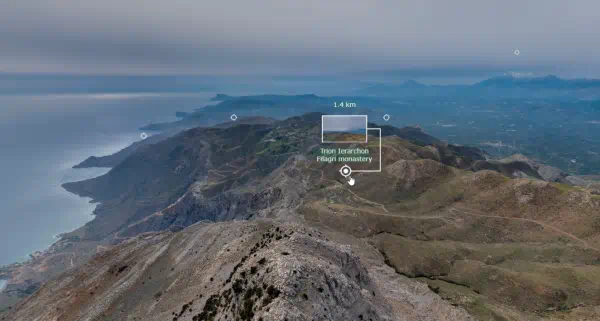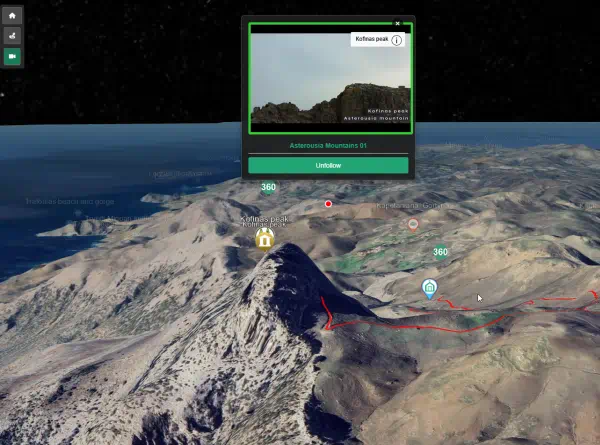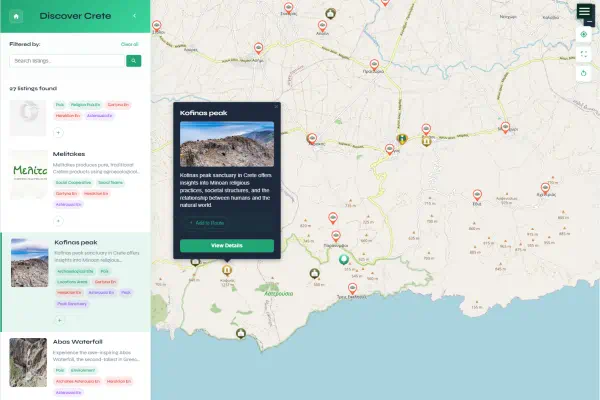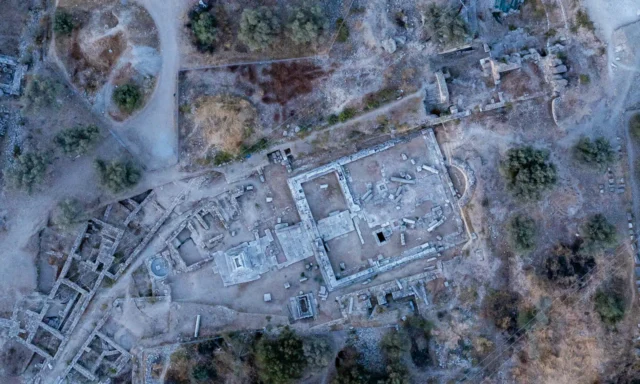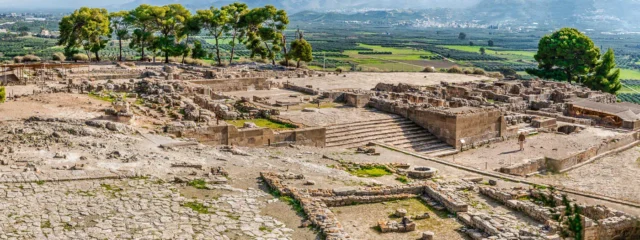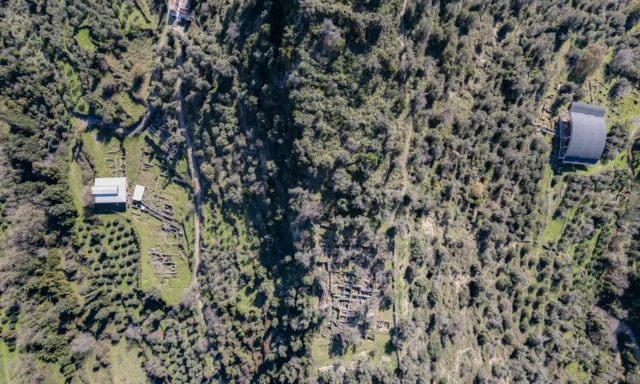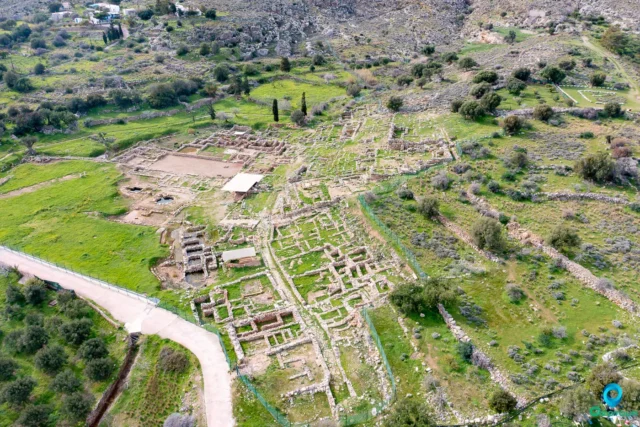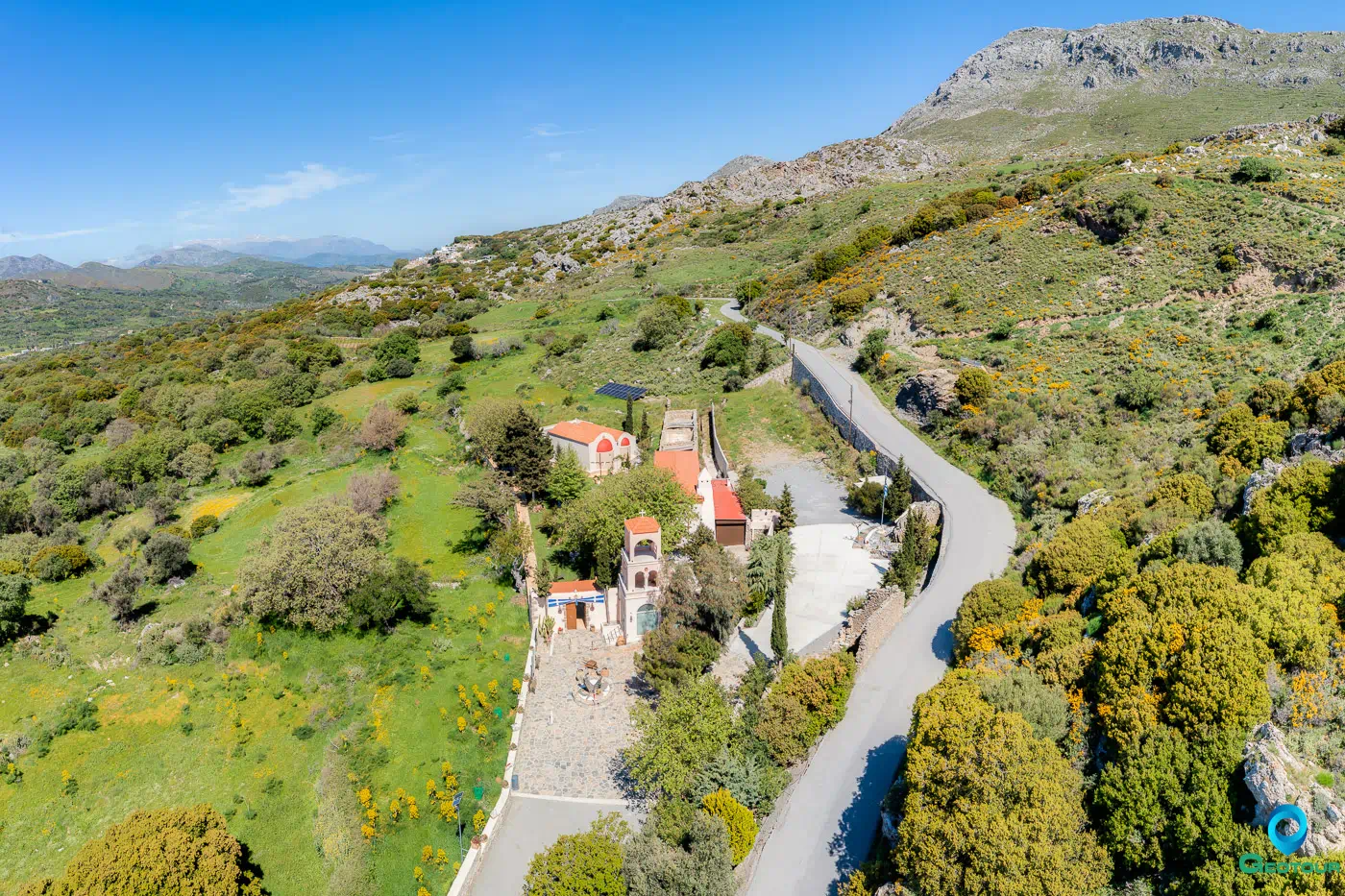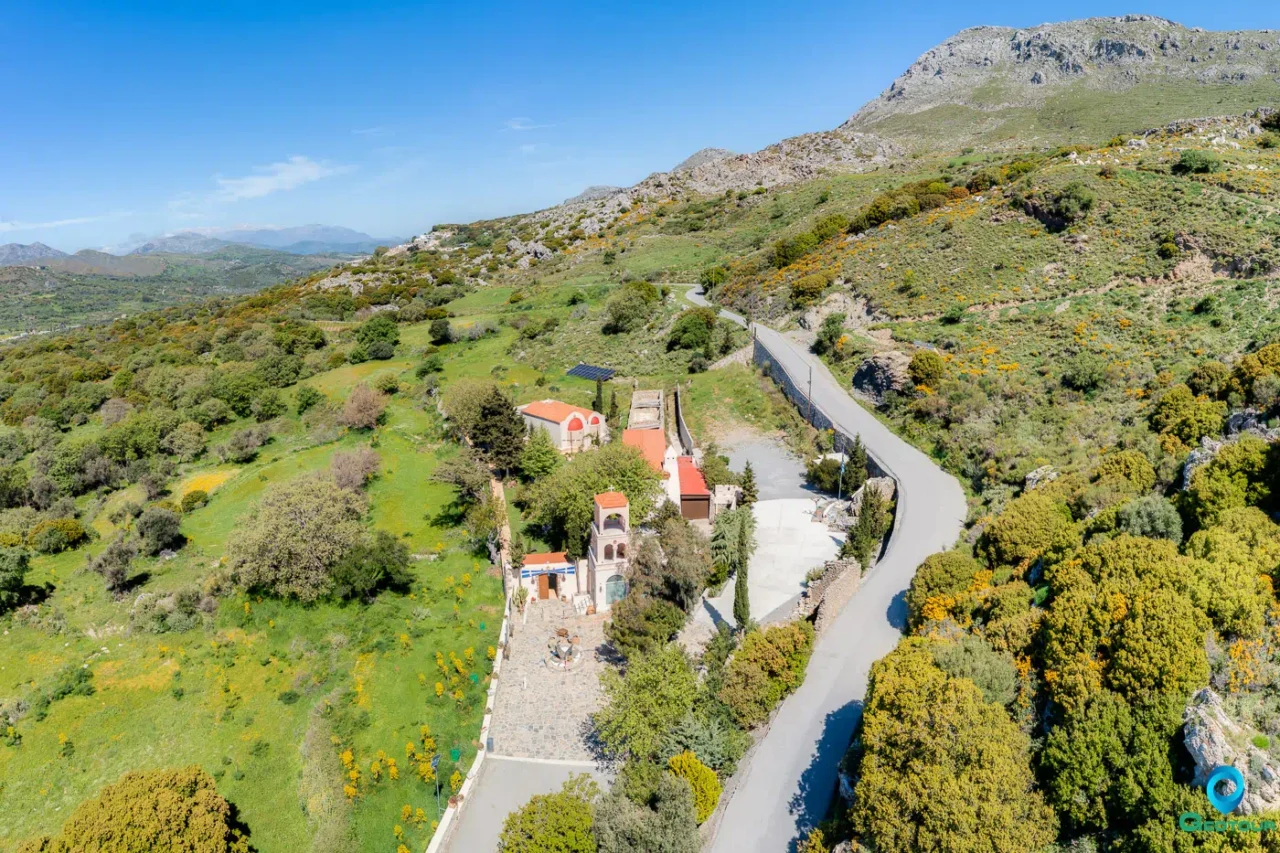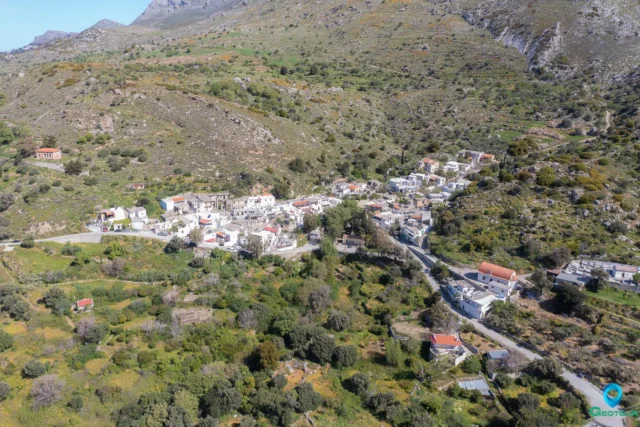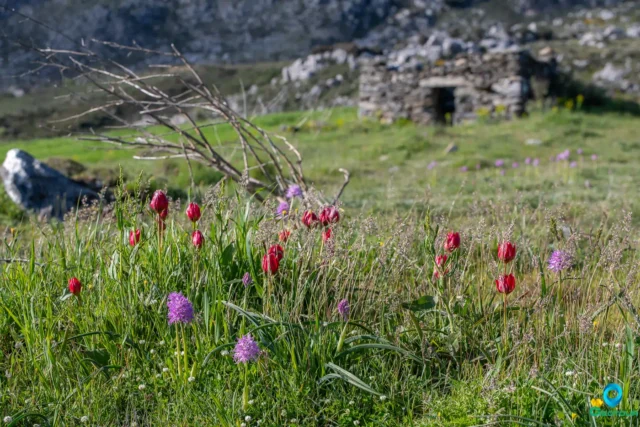The Monastery of the Holy Spirit (Greek: Μονή Αγίου Πνεύματος, Moni Agiou Pnevmatos) is a historical Orthodox Christian monastery in the Rethymno regional unit of Crete, Greece. It is located near the village of Kissos on the southern slopes of Mount Kentros (also known as Kedros). It is under the ecclesiastical jurisdiction of the Holy Metropolis of Lambi, Syvritos and Sfakia. The monastery has a long history, possibly dating back to the Byzantine era and was active during Venetian rule. It was destroyed during the Greek War of Independence in the early 19th century. Later, it became an important educational center for Crete under Ottoman administration. Currently, it is a restored and officially protected historical monument.
Geographical Location and Accessibility
The monastery is located outside the village of Kissos, less than 1km to its south-east. Kissos village is on the southwestern foothills of Mount Kentros, a mountain with an elevation of 1776 meters. The village is at an altitude of approximately 630 meters. The monastery is in a region that contains natural features like the Kissano Gorge and the Gious Kambos plateau and is among several local Byzantine and post-Byzantine historical monuments. During the Ottoman period, Kissos village was part of a larger administrative unit (municipality or δήμος) named Agiou Pnevmatos, based in Ardaktos.
You can access by a paved road that goes beyond Kissos village to the monastery towards Kentrochori.
Historical Overview
Foundation and Early History (Byzantine/Venetian Periods)
The exact foundation date of the Monastery of Agio Pnevma is uncertain. Historical sources and local traditions suggest different times. Some sources date its origins to the Late Byzantine period, between 961 and 1204 CE, while others suggest the 12th century or the beginning of Venetian rule in Crete (after 1204 CE). The nearby village of Kissos is thought to date back to the 9th or 10th century and developed significantly during the Second Byzantine period (961-1204 CE). This context supports the possibility that the monastery was founded before the Venetian era.
Local tradition attributes the monastery’s founding to a wealthy Byzantine noblewoman named Maria. She reportedly owned large areas of land from Mount Kentros to the Libyan Sea and was nicknamed “Aigidou” (Αιγιδού) because she had large flocks of goats (aiges in Greek). According to some versions of this tradition, she later became a nun and was buried at the monastery she founded.
Although its exact origins are unclear, the monastery’s existence and activity during the later Venetian period are well-documented. It is mentioned in Venetian administrative or church documents from 1635 and 1640, and in a 1658 document from the Hierodikeion (Ecclesiastical Court) of Rethymno. These records describe it as an independent and active institution in the mid-17th century. As a result, the Venetian Era (1204-1669 CE) is often considered an important period for the monastery. The alignment of suggested foundation dates (Late Byzantine/12th Century) with local tradition strongly indicates the monastery probably existed before the Venetians arrived, possibly starting in the Second Byzantine period, even though its documented importance came later.
Ottoman Era, Destruction, and Transformation
The monastery was destroyed at the start of the Greek War of Independence. On June 15, 1821, local Ottoman forces from the Amari valley region (Abadiotes or Amariotes) attacked the monastery. They killed the monks living there and burned the buildings, resulting in its destruction and abandonment.
After this destruction, the ruined monastery became a dependency (Metochi) of the Preveli Monastery, located further south in the same province. Some historical records about the Agio Pnevma monastery’s activities during the later Ottoman period are reportedly kept in the archives of Preveli Monastery.
In 1836, the site was repurposed for education. Nikodimos Soubasakis, the Bishop of Lambi at the time, established the “School of the Holy Spirit” (Scholi tou Agiou Pnevmatos) on the monastery grounds. This school quickly became important as a Greek educational institution in Crete during 19th-century Ottoman rule. It attracted many students seeking Greek language teaching and literacy from the surrounding provinces of Agios Vasileios and Amari, as well as from Rethymno town, the Messara plain, Sfakia, and the island of Gavdos. This educational role marked a significant change in the monastery’s use and was a key part of its activity during the later Ottoman period, contributing to Cretan cultural history.
Several individuals were involved with the school’s operation. Bishop Evmenios Xiroudakis was the only teacher in 1890, joined by Panagiotis Fotakis from Melampes in 1892. Notable students included Emmanouil Tsouderos from the nearby village of Asomatos, who later became Prime Minister of the Greek government-in-exile during World War II. Ioannis Alexandrakis, a writer who later documented the history of the monastery and school from his own experiences, was both a student and a teacher there. The educational use continued in 1899, during the autonomous Cretan State period, when the first formal Primary School for the surrounding villages was established at the monastery site.
Later Events and Recognition
The monastery grounds are also associated with an important event from the Cretan Revolution of 1866-69. A memorial is located in the courtyard commemorating a battle that happened nearby. On December 8, 1868, about 200 volunteer fighters, including Laconians (Maniates), Cretans, and Roumeliotes (from mainland Greece) led by Colonel Dimitrios Petropoulakis, fought Ottoman troops. The volunteers were defeated and killed in the battle.
There are indications that after the school closed, the monastery buildings became dilapidated over time. Parts of the complex were used as stables before restoration work began in the second half of the 20th century.
Efforts to increase awareness of the monastery’s historical importance grew in the mid-20th century. On June 14, 1964, the Rethymno branch of the Hellenic Mountaineering Club organized a trip and placed a commemorative plaque at the site, drawing attention to its history. Local cultural organizations, like the Kissos Cultural Association “To Agio Pnevma,” continue to help preserve the monastery’s history and traditions.
Recognizing its historical and cultural value, the Monastery of Agio Pnevma was officially declared a protected historical monument by the Greek Ministry of Culture and Sciences in 1980.
Historical and Cultural Significance
The Monastery of Agio Pnevma is significant to Cretan history and culture for several reasons.
- Religious Heritage: It represents centuries of continuous Orthodox Christian presence in the area. Its history likely begins in the Byzantine era, with documented activity during Venetian rule and continued operation during the Ottoman period, although it was violently destroyed in 1821. Its survival and recent reopening show its lasting importance as a religious site.
- Educational Legacy: The monastery’s change into the School of the Holy Spirit after 1836 was an important contribution to Cretan society during a difficult time. It served as a center for promoting Greek language, literacy, and cultural and religious identity under Ottoman rule, educating many Cretans from different areas. This educational role is a key part of its history.
- Symbol of Resistance: The monastery represents parts of the long Cretan struggle against foreign rule. Its destruction in 1821 shows the violence of the Greek War of Independence and how religious institutions were targeted. The site is also directly connected to the Cretan Revolution of 1866-69 through the 1868 battle and the memorial to the fighters who died there. This fits the historical pattern in Crete where monasteries often acted as centers of resistance or refuge.
- Cultural Landmark: Its official status as a protected historical monument by the Greek state confirms its cultural value. It is also considered an important part of the group of Byzantine and post-Byzantine historical sites near the village of Kissos, adding to the area’s cultural heritage.
Key Points
Construction Period: The foundation date is uncertain. Historical sources and local tradition suggest it could date from the Late Byzantine period (961-1204 CE), the 12th Century, or the Early Venetian period. Documents show the monastery was established and active by the mid-17th century.
Location: Located near the village of Kissos, on the southern slopes of Mount Kentros, in the Municipality of Agios Vasileios, Rethymno Regional Unit, Crete, Greece.
Dimensions: Specific dimensions for the monastery complex or the church are not available in the sources used.
Historical Significance: An Orthodox monastery with a long history through the Byzantine, Venetian, and Ottoman periods. It was destroyed during the 1821 Greek War of Independence. Later, it housed the important School of the Holy Spirit, a key center for Greek education and cultural preservation in 19th-century Crete. The site is also connected to the Cretan Revolution of 1866-69 through a battle and a memorial to fighters killed there.
Current Status and Condition: The Monastery of Agio Pnevma has been restored, mainly its main church (katholikon), and has officially reopened as a monastery. A key sign of this reopening is the recent appointment of an Abbot (Ηγούμενος), Archimandrite Bartholomew Xeroudakis, who is reportedly the first person in this role at the monastery in about 200 years.

